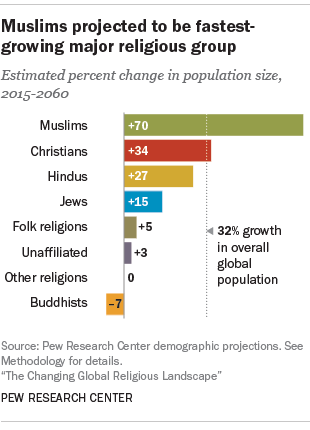TWH –The newest report on global trends in religion from the Pew Research Center, titled “The Changing Global Religious Landscape,” was released early last month. The data within that report suggests that the “rise of the nones” will be reversed by the disproportionately small number of children born to those who don’t identify with a religion, including atheists and agnostics.
There are hints that the various Pagan and polytheist religions may increase in absolute number of adherents, but nevertheless result in a smaller percentage of world population. Overall, Muslim women currently have more children than those in any other category, which is a trend predicted to continue at least through 2060, at which time Islam is predicted to have more followers than any other religion on Earth.
 Data collected in 2010 led to the conclusion that people espousing no particular religious beliefs were more numerous than those of any religion, with the exception of Christianity and Islam. The report issued in April shows that birth and death rates should halt what was widely predicted to be a rise of non-religious “nones” over the next few decades.
Data collected in 2010 led to the conclusion that people espousing no particular religious beliefs were more numerous than those of any religion, with the exception of Christianity and Islam. The report issued in April shows that birth and death rates should halt what was widely predicted to be a rise of non-religious “nones” over the next few decades.
That fits into a wider trend that shows the fastest rates of population growth through 2060 are likely to be in sub-Saharan Africa, where the median age of people is low in general, and mortality rates are dropping. Both Islam and Christianity are strongly represented in that part of the world, with Muslims’ numbers edging out their Christian cousins by virtue of the highest number of live births per woman, at 2.9. The prediction is that there will be three billion Christians in 2060, but 3.1 billion Muslims.
By contrast, 75% of atheists and other nones live in Asia, where the median age is much higher, suggesting that population growth will continue to decline. That’s also the reason that Buddhism, which is largely centered in that part of the world, is the only religion tracked separately in the survey and is expected to have fewer adherents by 2060. Nones, which were close to 1.2 billion strong in 2015, will finally surpass that number by 2060, but that will represent a drop from 16% to 13% of world population.
The murky “other” category, which is where Wicca is included, is also expected to drop in absolute number of participants. Folk religions, which may be where some other Pagan-labeled relgions were categorized, are expected to have more followers by that time, but not enough to keep the percentage in the world population from shrinking.
The categorization of Pagan and polytheist religions other than Wicca continues to be unclear. Wicca is specifically listed as an example of the groups listed as “other,” but Heathens and groups with still smaller numbers are not specifically mentioned.
The definition of “folk religions,” as given in an appendix, indicates these faiths are “closely tied to a particular people, ethnicity, or tribe. In some cases, elements of other world religions are blended with local beliefs and customs. These faiths often have no formal creeds or sacred texts.”
It’s plausible that Heathenry and other religions with strong ethnic traditions are lumped into that category, but a request for comment sent to Pew researchers did not elicit a response in time for this story. An analysis of sources used shows that Heathens, at least, were included in the study, albeit quite indirectly: one source for this report was the Association of Religion Data Archives, which references work on Heathenry by Jennifer Snook, and was based at least in part on Heathen census work undertaken by Dr. Karl E.H. Seigfried.
Jews, at 14.3 million in 2015, were the smallest group tabulated separately; that appears to be the mark to reach before studies of Pagan and polytheist religions to have even a firm footnote in future religious landscape studies. Partial funding for past religion reports came from the evangelical Protestant John Templeton Foundation, but at this point there’s no indication that the lack of meaningful data about Pagan and polytheist populations is driven by anything but the numbers.
* * *
The work of journalist Terence P. Ward was made possible by the generous underwriting donation from Hecate Demeter, writer, ecofeminist, witch and Priestess of the Great Mother Earth.
The Wild Hunt is not responsible for links to external content.
To join a conversation on this post:
Visit our The Wild Hunt subreddit! Point your favorite browser to https://www.reddit.com/r/The_Wild_Hunt_News/, then click “JOIN”. Make sure to click the bell, too, to be notified of new articles posted to our subreddit.